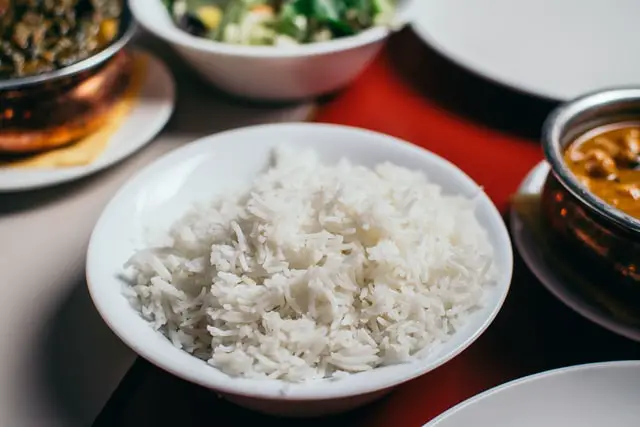You’re not always going to be precise with cooking measurements, or put honestly, you simply can’t in some situations, because of many inevitable reasons. So in any case you’re left with extra cooked rice stored somewhere on the kitchen countertop — whether white or brown, jollof or plain, read this article as efficiently as you can and return back to the rice as quickly as possible. You’ll find out why in a moment.
Can you freeze cooked rice?
Whether milled or brown, cooked rice can be safely packaged in a plastic bag and frozen for upto six months without having any significant changes in quality and freshness.
It’s actually recommended that every leftover or extra cooked rice be stored in this manner to reduce the risk of food poisoning caused by a spore generating bacteria known as Bacillus cereus. More on that below.
How to properly freeze cooked rice
Cooked rice is safe to freeze indefinitely provided it’s held at 0 F or temperatures below, according to an article published by the University of Nebraska.
In order to preserve optimal quality and taste during cooking however, it’s best to preserve the rice as plain as possible and use it within the first six months of freezing. As plain as possible means to avoid freezing with toppings and other creamy additions such as coleslaw — if you and the kids devoured the first batch like that after cooking.
Rice cooked with vegetables, seasoning or shredded meat is also safe to cool and pop into the freezer compartment, and just like any rice cooked naked or plain, its maximum quality is best reaped when used within the first few months of freezing, especially if the vegetables aren’t blanched which can cause them to lose texture, sharpness and even go bad quickly.
While it’s easily established that cooked rice, no matter the type and cultivar you’re working with is safe to put in the freezer for as long as you desire, there’s actually one serious caveat tied with this process that you should never ignore, otherwise, you risk ending up in the hospital following a serious infection.
Yes, you heard that right. Reheating and consuming frozen cooked rice could be the very reason why you end up in the hospital. But freezing itself isn’t the problem, it’s the way the rice was handled before freezing that makes the difference.
Here’s the thing. Uncooked rice often contain a bacterium known as Bacillus cereus acquired as a parting gift from the soil in which the rice was grown in.
The bacterium is notoriously stubborn and can survive high heat cooking simply because of one terrific adaptation it has, and that’s the ability to form spores which acts as a protective shield against the unfavorable cooking conditions.
This means that fully cooked rice may still be contaminated with Bacillus cereus even though it had been subjected to high temperatures for long duration. The worse thing? Bacillus cereus has been linked with food poisoning with very serious side effects such as abdominal cramp, diarrhea or vomiting within 15 – 30 minutes of ingestion.
So how does all these link up to storing cooked rice in the freezer?
Well it’s simple, bacterium like the Bacillus Cereus grow rapidly at temperatures between 4 to 60 C also known as the danger zone.
If you don’t already know, this range corresponds to the 2 or 3 hours cooling period you normally leave cooked rice on the counter, in a covered pot on the stovetop, or in a lidded storage container for later reheating and then consumption.
And no, you won’t see the bacteria growing on the surface of the rice because it’s pathogenic and microscopic, and you won’t be able to smell or taste it’s presence either. It’s just like eating a regular bowl of rice, but this time, with every spoonful aiming to clear your doubts after some few minutes.
What does all these translate to?
It means that you must and should freeze up any leftover or extra cooked rice as quickly as possible (preferably in less than an hour), otherwise, you’ll end up with lots of this microscopic bacterium which will produce the toxins that will contaminate the food and make you sick, especially if you’re already compromised or vulnerable — a sick person, an elderly or an innocent child.
If you go ahead and freeze after two to three hours of cooling at room temperature, you’ll only stop the germination of the spores temporarily, and the moment you take out the rice from the freezer and reheat on the stovetop or in a microwave, it’ll be back alive and even healthier than before!
If you don’t want to freeze, you can always go the route of holding the rice at temperatures greater than 65 C, but exactly how to do that without overcooking is simply what i don’t know.
For those that want to freeze, here’s how to do so
Step 1: Do not cook more rice than you ever need. Yes, bear the pain of cooking the brown or white rice all over again. It may be time consuming, but it’s better than having to deal with a serious diarrhea!
Step 2: Cool freshly cooked rice quickly in several shallow containers like plastic containers, (no more than 10 cm deep) optionally dipped in an ice bath. Use no more than an hour. Or, you can cool the entire rice in a colander under cold running water. It’s much faster. Or, you can allow the rice to get warm, then portion it into several shallow containers and put in the refrigerator below 5 C (41F) to cool quickly and safely.
Step 3: Once the food has properly cooled, transfer it into a quality plastic freezer bag in measured quantities (you know your family’s needs best), and label with the name of the product, date of freezing, and the expected date for thawing or use.
Step 4: Pop in the freezer and make sure to leave enough space for air flow between the containers so the foods freeze up quickly, this will preserve the quality better. Make sure you don’t stack the bags over another.
How to refrigerate cooked rice
If cooked rice is intended to be used in 3 to 5 days’ time, it’s best to refrigerate at temperatures below 5 C. That’ll preserve the texture even better. To refrigerate, simply follow the instructions outlined in step 1 and step 2.
Make sure you don’t stack containers over the other to allow for quick cooling which will prevent germination of the sprouts, and also loss in quality texture.
How to reheat frozen/refrigerated cooked rice
When it comes to reheating, you can use the stovetop or the microwave, but you have to make sure that the internal temperature registers 165F with a food thermometer, or the food is steaming hot everywhere.
To reheat on the stovetop:
Transfer one cup of (refrigerated) rice into a pot or pan and sizzle with 2 tablespoon of water. Mix well, cover and heat on low until the food gets heated through completely. Make sure to constantly turn the rice for even heat distribution.
For frozen rice, you obviously can’t mix at first, so allow to thaw a bit, then mix.
To reheat in a microwave:
Transfer one cup of (refrigerated) rice into a microwave safe bowl and sizzle with 2 table spoon of water. Mix well, cover with wax or parchment paper and microwave on high until completely heated through – it takes about one minute.
For frozen rice, microwave on high until heated through — takes about 2 to 3 minutes.
Tips:
- You can thaw frozen rice in the refrigerator to speed up the reheating process in the microwave or stovetop.
- You can eat rice in it’s cold refrigerated state. It’s completely safe (so far you’ve observed all the earlier protocols carefully and handled the rice properly). In fact, cold rice is speculated to improve the blood sugar levels as well as that of cholesterol.
- Once you’ve reheated rice, never repackage and prepare as per the instructions above and store in the freezer or refrigerator again. That’s why it’s important you portion the rice well and into different freezer bags during the first freezing.

